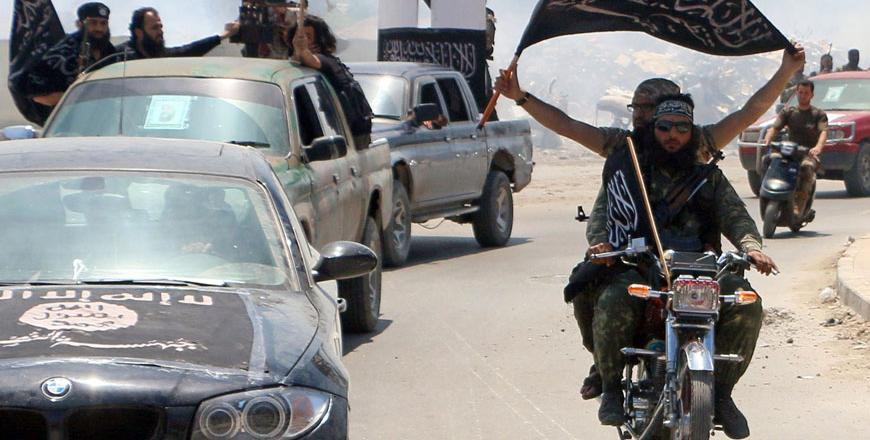You are here
The Syrian Al Nusra Front
By AFP - Jul 28,2016 - Last updated at Jul 28,2016

This file photo posted on the Twitter page of Syria’s Al Qaeda-linked Al Nusra Front on April 1 shows fighters from Al Qaeda’s branch in Syria, Al Nusra Front, marching towards the northern village of Al Ais in Aleppo province, Syria (AP photo)
BEIRUT — Al Nusra Front, whose leader on Thursday announced its break from Al Qaeda, is a well-organised, battle-hardened extremist group allied with rebels fighting the Syrian regime.
Abu Mohamad Al Jolani said Al Nusra would change its name to Jabhat Fateh Al Sham (Front of the Conquest of Syria) and thanked the “commanders of Al Qaeda for having understood the need to break ties”.
The rebranding aims “to further embed itself [Nusra] into Syria’s revolution and secure its long-term future” as a mainstream rebel group, rather than be targeted like the Daesh terror group by foreign powers, analyst Charles Lister tweeted.
Al Nusra first emerged in January 2012, 10 months after the start of anti-government protests that were brutally repressed by President Bashar Assad’s regime, leading to a now more than five-year-old multi-sided conflict.
The group is an offshoot of Daesh in Iraq, Al Qaeda’s former affiliate in the country, in which Jolani was a leading figure in Nineveh province, a militant stronghold in the north.
In April 2013, Al Nusra refused to join up with Daesh and pledged allegiance instead to Al Qaeda head Ayman Al Zawahiri, who later proclaimed Al Nusra the only branch of Al Qaeda in Syria.
After that declaration, Daesh pushed Al Nusra out of its base in eastern Syria’s oil-rich province of Deir Ezzor.
7,000 to 8,000 militants
Al Nusra counts 7,000 to 8,000 fighters, according to Thomas Pierret, a Syria specialist at the University of Edinburgh.
“There are quite a few foreigners among the middle managers and less among the fighters,” he said.
Syria analyst Aymenn Al Tamimi put the number of Al Nusra militants at between 5,000 and 10,000 — with 80 percent of them Syrians.
According to Pierret, Al Nusra’s “centre of gravity” is in Syria’s northwestern Idlib province and the southern part of Aleppo province, in the north.
But “there is no territory exclusively controlled by Al Nusra”, he said.
“Even in areas were they are very influential, like in certain parts of Idlib province, other groups coexist with them.”
It is Syria’s preeminent extremist force, along with its key rival, Daesh.
But unlike Daesh, which opposes all those who fail to swear allegiance, Al Nusra works alongside an array of rebel groups fighting Assad’s regime and has popular support.
“IS [Daesh] considers itself to be a state and other armed groups who do not pledge allegiance to be illegitimate,” Pierret explained.
Al Nusra believes it can “confront certain rebel factions over ideological differences but without rejecting the existence of all other groups in principle”, he added.
Tamimi said both groups shared the goal of creating a “global caliphate” but that Al Nusra had “a more subtle long-game approach focused on trying to build popular support”.
Murky financing
Al Nusra’s “financing is rather murky”, Tamimi added. “But it’s clear there have been ties with some elements of Turkish intelligence and Gulf donors in the past.”
Pierret said: “Qatar has long tolerated private fundraising for Al Nusra from its territory and Turkey has facilitated Al Nusra’s operations along its border.”
Al Nusra Front has been targeted by US-led air strikes on several occasions, but less often than Daesh. Since September 2015, it has mainly been a target of air strikes by Russia, Assad’s main ally.
Related Articles
BEIRUT — Al Qaeda's Syria franchise is striving to reinvent itself as a legitimate opposition force that is more acceptable to the West, but
BEIRUT — US-led aircraft bombed Daesh fighters as they battled rival Syrian rebels, including Al Qaeda loyalists, for the first time, a moni
Militants linked to Al Qaeda dealt a major blow to Syria's regime on Monday by seizing two key army bases within hours, giving them control over most of Idlib province.















